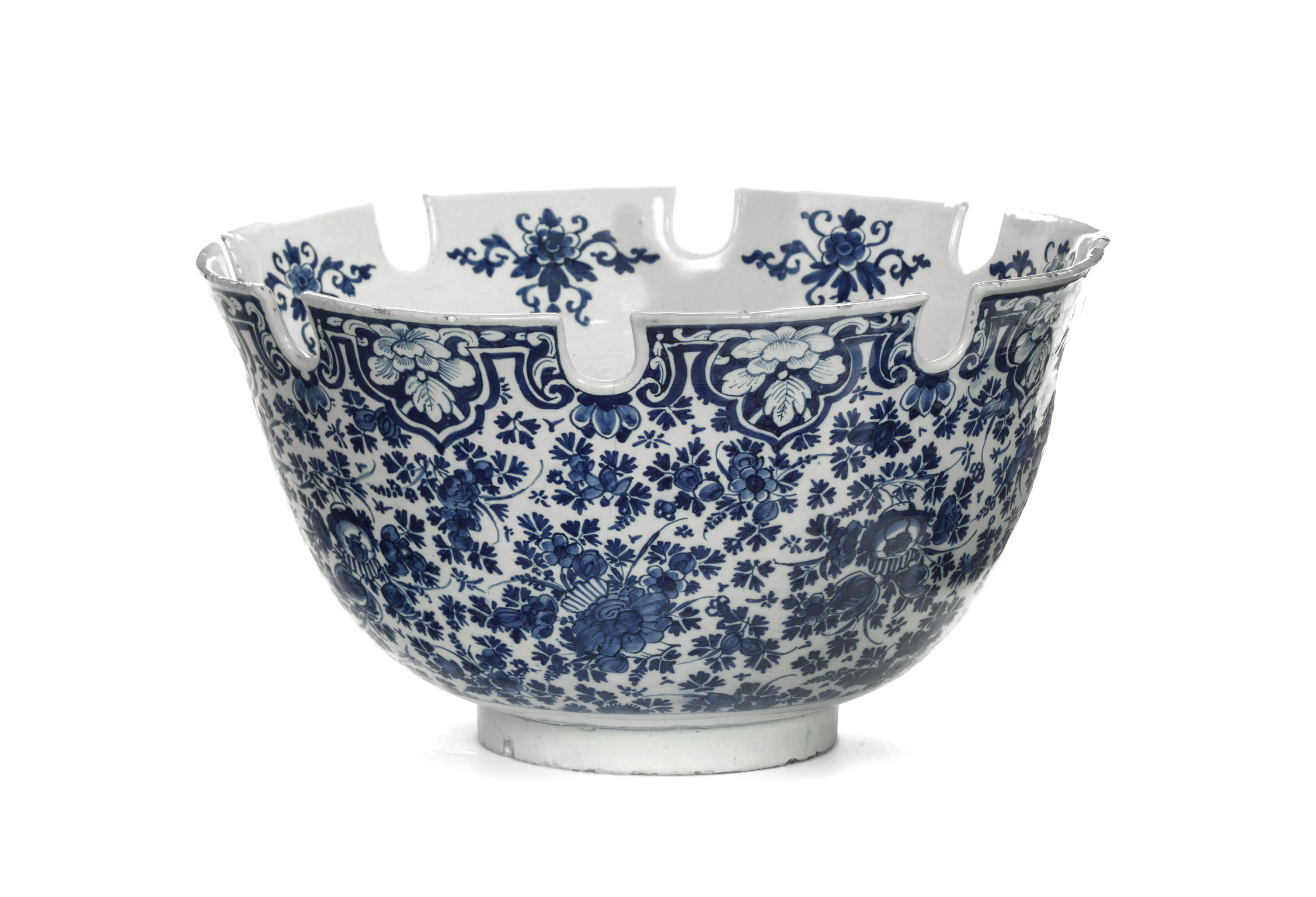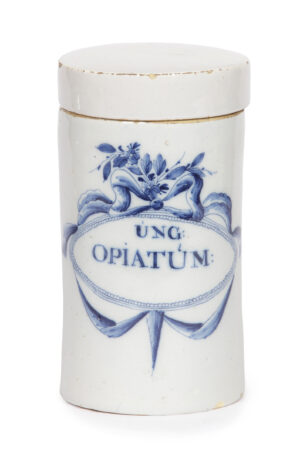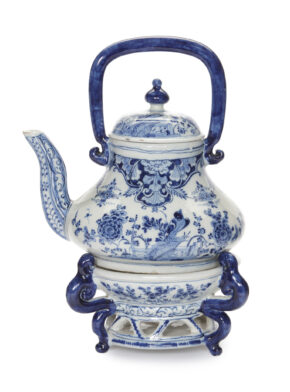![]()
Images on this website are licensed under a
Creative Commons Attribution-NoDerivs 3.0 Unported License.
OBJECT
D2314. Blue and White Monteith
Delft, circa 1710
Attributed to Lambertus van Eenhoorn, the owner of De Metaale Pot (The Metal Pot) factory from 1691 to 1721
Painted around the exterior with floral and foliate sprigs and sprays interspersed with small clusters of dots between floral-patterned blue-ground lappet borders between the eight notches around the rim, and the interior with similar floral and foliate sprigs and spray decoration in a roundel edged by a scroll border below eight floral scrollwork motifs between the notches.
DIMENSIONS
Height: 19.6 cm. (7.7 in.); Diameter: 35.3 cm. (13.9 in.)
NOTE
Wine glass coolers are often considered a late seventeenth-century French invention, circa 1680, initially created in silver to accompany the wine fountain or cistern and the wine bottle cooler in the increasingly grand displays of plate or silver furniture of kings, princes and ambassadors. However, the form appears simultaneously in English silver, and according to H. Coutts, The Art of Ceramics, European Ceramic Design 1500-1830 (New Haven and London, 2001), pp. 80-81, in England, where the newness of the coolers was mentioned in 1683, they were named ‘monteiths’ after a Scottish nobleman who was known to wear a cloak with a serrated hem. The earliest silver wine glass coolers were round or oval, often with lion’s-paw feet and handles formed as lion’s heads holding rings in their mouths. The cooler was filled with ice or cold water, and the glasses were suspended upside down with their bowls in the cooler and their feet supported by the scalloped rim. If large enough, the cooler could also be used to chill wine bottles in the ice (see Kievit and Klüver 2015, pp. 94-95). At the time, the larger houses and castles had ice-cellars dug deep into the ground, in which temperatures stayed low, and ice, harvested from ponds during the winter and packed in straw, could be stored during the warm summer months.
By the late seventeenth century, the French court of Louis XIV (1638-1715) was the model of splendor and taste for all of Europe. While his display of wealth in silver was the envy of every court, it was not invulnerable. France’s involvement in expensive wars forced the king to order all available silver to be melted down (including the silver furniture
at Versailles), first in 1689, and again in 1708, to replenish the country’s coffers. In the process, the king replaced his silver service with a Chinese porcelain blue and white service. As a result, the French faience industry increased the production of both ornamental and functional pieces, worthy of royal and aristocratic tables. In their sudden need for such silver substitutes, the marchands merciers had to reach beyond the local factories to potters in other parts of Europe, and particularly in the nearby Netherlands. It was for this reason, among others, that at this time many pieces of earthenware, particularly Dutch Delftware, were created of the highest quality, following the shapes of the original silver objects: dishes, candlesticks, salt cellars and sugar casters. The potters also fearlessly undertook the larger and more impressive objects: fountains or cisterns, wine coolers, flasks and bottles, all forms of vases and flower containers, and even centerpieces. The popularity of refined faience on the dinner tables of the European courts and noble houses increased the prestige of Delftware, and the pieces created at the end of the seventeenth century and the beginning of the eighteenth century came to rival and sometimes even surpass their silver counterparts.
This rare type of Delft object probably already belonged to the production range of the previous owner Lambertus Cleffius. In his inventory,glass coolers are indicated with the description of ‘koelbakjes met holletjes’ (‘refrigerated trays with holes’). Inventories also mention cooling vessels available in several sizes.
SIMILAR EXAMPLES
The floral decoration on this bowl enjoyed a certain popularity at the turn of the eighteenth century. The style appears on a variety of wares produced by De Metaale Pot (The Metal Pot) under the ownership of Lambertus van Eenhoorn, including two jars illustrated in Boyazoglu 1983, p. 91 no. 180 and p. 91 no. 181, a ewer and a bottle vase illustrated in Aronson 2004, p. 45, no. 45 and 46 and a pewter mounted ewer in Aronson 2012 p. 54, no. 34. A smaller bowl decorated with a similar ‘parsley’ motif is in the collection of the Cooper Hewitt Smithsonian Design Museum in New York (inv. no. 1986-61-49).
An almost identical decorated glass cooler marked for Lambertus van Eenhoorn, but of smaller size, in the Kunstmuseum, The Hague (inv. no. OC(D)7-1998), is illustrated in Van Aken-Fehmers 1999, p. 182, no. 65. A second monteith, marked for De Metaale Pot factory, is also housed in the Kunstmuseum, The Hague (inv. no. 1018458). Another monteith of 48.5 cm. is illustrated in Lunsingh Scheurleer 1975, p. 46, fig. 15.). Another monteith of this model, but marked for Adrianus Kocx of De Grieksche A (The Greek A) factory, was auctioned at Frederik Muller & Cie Amsterdam, 28 April-1 May 1908, lot 7. Of the same factory, but marked for Pieter Adriaensz Kocx, a monteith was sold at Brunk auctions, March 26 2022, lot 893. A monteith of similar model and size from circa 1700-1710, but decorated with scenes of putti and fountains is in the collection Historic Deerfield (inv. no. HD 67.103).









